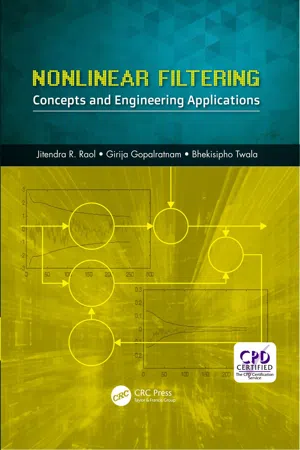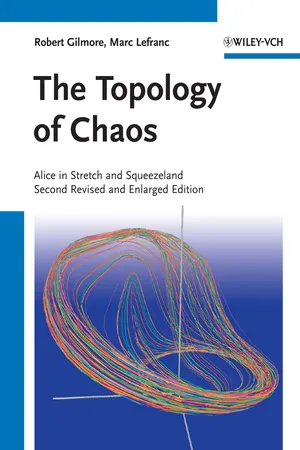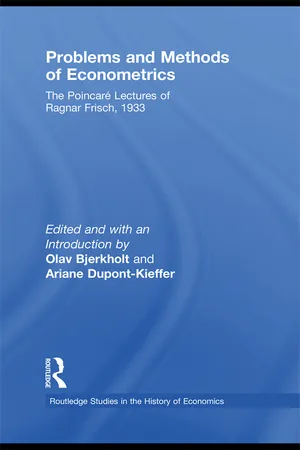Physics
Dynamic Systems
Dynamic systems in physics refer to systems that change over time due to the interaction of various components or forces. These systems are characterized by their ability to exhibit complex behaviors and patterns, often influenced by feedback loops and non-linear relationships. Understanding dynamic systems is crucial for analyzing and predicting the behavior of physical phenomena, such as oscillations, chaos, and emergent properties.
Written by Perlego with AI-assistance
Related key terms
7 Key excerpts on "Dynamic Systems"
- eBook - ePub
Nonlinear Filtering
Concepts and Engineering Applications
- Jitendra R. Raol, Girija Gopalratnam, Bhekisipho Twala(Authors)
- 2017(Publication Date)
- CRC Press(Publisher)
1 Dynamic System Models and Basic Concepts We present some basic aspects of mathematical models (and modelling) of Dynamic Systems that one encounters in the real world. In order to achieve desired performance from real-world systems, we need to have a mathematical model (in most, if not all cases) of the system, mainly because analysis and control of such systems is accomplished by using their mathematical models that are obtained using the measured responses of (and inputs to) the systems, the dynamics of which could vary with time, space or both. Variation of dynamic system characteristics could be linear or nonlinear. Mathematical modelling of systems in both continuous time and discrete time is essential for analysis. 1.1 Dynamic Systems: The Need for Modelling, Parameter Estimation and Filtering A system is defined as a set of interconnected components that work together to accomplish a specified mission for, say, chemical plants (industrial systems), aerospace vehicles, robotic systems, nuclear reactors, computer networks and the economy (system of economics) of a country. Although the terms system, plant and process are synonymously used in estimation/control literature, and can be used to describe any of these systems, a distinction is sometimes made between plant and systems as in chemical plant and computer systems (and aerospace control system). In response to input excitations, the behaviour of most of the physical (nonlinear) systems would change with time or space. In order to understand and characterize the performance of these Dynamic Systems, we need their mathematical models. Mathematical models of Dynamic Systems are formulated using a collection of input/output (I/O) variables/signals/data of the system and processing these in some algorithm to determine the structure and parameters of the proposed model - eBook - ePub
The Topology of Chaos
Alice in Stretch and Squeezeland
- Robert Gilmore, Marc Lefranc(Authors)
- 2012(Publication Date)
- Wiley-VCH(Publisher)
Chapter 3 Continuous Dynamical Systems: FlowsAll of the physical systems we deal with in this book are described by sets of coupled nonlinear ordinary differential equations. Such systems share many common features. In this chapter we survey the properties of such systems. The discussion ranges from the fundamental theorem of dynamical systems theory, the existence and uniqueness theorem, to the fundamental idea behind the classification of strange attractors. This idea is that most of the dynamics described by a set of ordinary differential equations is understood once the two basic mechanisms that operate in phase space have been identified. These mechanisms are stretching and squeezing.3.1 Definition of Dynamical SystemsDefinition 3.1 A dynamical system is a set of ordinary differential equations of the form(3.1)Here x = (x 1 , x 2 , …, x n ) R n are called state variables and are called control parameters . The functions F i (x ; c ) are assumed to be sufficiently smooth.Remark 1The state variables and control parameters are usually considered to be in subspaces of Euclidean spaces, but they may more generally be in n - and k -dimensional manifolds.Remark 2The space of state variables is often called the phase space .Remark 3 Initial conditions for any solution of the dynamical system equations belong in the phase space.Remark 4The functions F i (x ; c ) are usually assumed to be differentiable over the region of interest, but a Lipschitz condition is sufficient for the most important properties of dynamical systems which we will exploit: the existence and uniqueness theorem (cf. Section 3.2). In most cases of interest, the functions F i (x ; c ) are polynomials in the x j whose coefficients depend on the control parameters c . Such functions are Lipschitz on bounded domains in R n .Remark 5If the functions F i (x ; c ) are not explicitly dependent on time (i.e., ∂F i /∂t = 0, all i ) the system is said to be autonomous . Otherwise, it is said to be nonautonomous . It is often possible to replace a nonautonomous system of equations in n - eBook - ePub
- Ragnar Frisch, Olav Bjerkholt, Ariane Dupont-Kieffer, Olav Bjerkholt, Ariane Dupont-Kieffer(Authors)
- 2009(Publication Date)
- Routledge(Publisher)
What is then the nature of a free variation, and more particularly, how can this notion be connected to the notion of dynamics as I have defined it? I have said that if we develop a theory where all the relations entering into it are static relations, then we shall have a situation where either the theory is indeterminate, or the system is locked with no evolution. On the contrary, if we have a theory where one of the relations is a dynamic relation in the sense I have defined it, then the possibility exists for pushing the analysis until a point where it becomes determined, without, however, locking the system. To put it another way, a theory which is dynamic in this sense is a theory able to explain movement in an intrinsic and determined way. In such a theory we first make a complete list of all the variables we will study. That is the problem of specification. Afterwards we can specify a number of equations equal to the number of unknowns, i.e. the problem of determinateness. If at least one of the equations is a dynamic equation then we have determined as many time curves as we have unknowns. Of course, it could be the case that one or more of the unknowns were found to be constants, but that will be just a special case. Most often the parameters determined in such a way will vary over time.The solution of a dynamic system such as I have envisaged here needs to be made precise also by initial conditions. However, it is a point of less importance in this connection.The essential character of a dynamic analysis is that it explains how a system, so to say, grows by itself. The theory explains how the situation from one given point in time necessarily changes by the fact that the situation of the system in the previous moments is given. Such a theory explains how the past determines the future. We see well that this must be the character of a system which is dynamic in the sense I have made precise at the beginning of this lecture. I have defined a dynamic relation as a relation with values for a certain variable both for one point in time and for another point in time. This connection between the definition of essentially dynamic theories and the distinction between forced oscillations and free oscillations seems to us to indicate the plausibility of the definition which we have adopted.In my opinion the true problem of economic life consists of tackling it as free oscillations. It is necessary to study the dynamic laws which can explain how a subsequent situation grows out of a previous situation. The economist must not be satisfied with being able to explain merely that if this or that parameter in the economic system varies cyclically, then the other parameters will also do so. He must have a larger claim; he must be able to explain how the situation at a given point in time has developed in a determined way from a previous situation. - Reinette Biggs, Alta de Vos, Rika Preiser, Hayley Clements, Kristine Maciejewski, Maja Schlüter, Reinette Biggs, Alta de Vos, Rika Preiser, Hayley Clements, Kristine Maciejewski, Maja Schlüter(Authors)
- 2021(Publication Date)
- Routledge(Publisher)
The modern notion of dynamical systems began with the work of Poincaré (1890; see Holmes 2007), who studied the qualitative dynamics generated by systems of non-linear differential equations. The advent of modern digital computing permitted advances in the numerical study of dynamical systems, most famously when Edward Lorenz, a meteorologist, discovered sensitivity to initial conditions, later named chaos, when performing computer simulations of air movement in the atmosphere (Lorenz 1963). Concepts such as chaos and bifurcations were mathematically formalised in the 1980s through work by researchers such as Guckenheimer and Holmes (1983). These and other dynamical systems concepts have influenced the development of many classical concepts used first in theoretical ecology and later in research on the resilience of SES, such as feedbacks, attractors, regime shifts, slow and fast variables, and definitions of resilience itself.SUMMARY TABLE: DYNAMICAL SYSTEMS MODELLING DISCIPLINARY BACKGROUND KNOWLEDGE TYPE The methods in this chapter are derived from or have most commonly been used in: Mathematics, Physics, Ecology, Business The methods in this chapter are primarily used to generate the following types of knowledge: - Exploratory
- Explanatory
RESEARCH APPROACH PURPOSE OF METHOD The methods in this chapter originate from or most commonly adopt the following research approaches: - Analytical/objective
- Collaborative/process
The most common purposes of using the methods in this chapter are: - System understanding
- Stakeholder engagement and co-production
- Policy/decision support
TEMPORAL DIMENSION SYSTEMIC FEATURES AND PROCESSES The methods in this chapter are most commonly applied to the following temporal dimensions: - Present (typically within the last 5–10 years)
- Recent past (post-1700s)
- Future
While most methods can do many things, the methods in this chapter are particularly good (i.e. go-to methods) for addressing the following: - eBook - ePub
Introduction to Civil Engineering Systems
A Systems Perspective to the Development of Civil Engineering Facilities
- Samuel Labi(Author)
- 2014(Publication Date)
- Wiley(Publisher)
The implication of the dense periodic orbit is that “every point in space is approached closely by periodic orbits in an arbitrary manner”; topologically transitive processes that do not have this condition may not indicate any significant sensitivity to the initial conditions and therefore are not likely to exhibit chaotic behavior (Devaney, 2003). The irrational rotation of a circle has been cited in the literature as a classic example of a process that is topologically transitive but does not have a dense periodic orbit and hence lacks any sensitive dependence on the initial conditions. In general, chaos theory has been applied in real-time or short-term weather predictions and in ecology population studies.Summary
A conundrum often faces civil engineers in cases where they struggle to reliably explain or predict some system outcome that is the culmination of a complex medley of multiple, interacting factors. These factors, which are associated with the system, its environment and operating condition, or its users, are often themselves outcomes of other factors, further complicating the prediction process. Any analytical tool that addresses not only the endogenous but also the exogenous nature of these factors by incorporating the key relationships between the factors is more likely to yield a more reliable prediction of system outcomes in such complex environments. System dynamics is a tool that provides such prediction capabilities because it incorporates the concepts of holism, factor interrelationships, and internal time-delayed feedback loops to yield potentially greater understanding of the timewise behavior of dynamical complex systems.In this chapter, we first learned some basic terms and concepts that are critical to the understanding of system dynamics as an analytical tool for describing how a complex, system works and how some output of such systems could be reliably predicted. We then learned about the various patterns by which some system variable may vary with time, namely, the linear, exponential, and goal-seeking patterns, and four different oscillation patterns.We also saw how the time-delayed effects could be accommodated in a model using feedback loops and stocks and flows, and thus discussed two central concepts in system dynamics. The first of these is the causal loop diagram, a convenient graphical representation of Dynamic Systems that captures and quantifies the feedback loops or relationships between the various entities in a dynamic, complex system. The second was stocks-and-flows, which quantify and track the changing levels of some attribute that increases and/or decreases at the same or different times due to external factors; we also reviewed the mathematical relationships that help predict the outcomes of different combinations of inflow and outflow patterns. - eBook - ePub
Information Systems
Debates, Applications and Impacts
- Priya Seetharaman, Jocelyn Cranefield(Authors)
- 2019(Publication Date)
- Routledge India(Publisher)
A. System dynamics is problem-oriented
A system dynamics model is developed in the context of a problem. A problem arises when the system fails to achieve the desired value. In the context of a problem being faced presently, it is the shortfall between what is desired and what is achieved. In the context of a future anticipated problem, it is the shortfall between what is desired and what is most likely achievable in the future. In the system dynamics modelling approach, the first thing one does is to define the problem dynamically by drawing the reference mode of behaviour. The reference mode of behaviour is a time plot of the most important variables of the system. For example, the problem of declining sales and rising inventory in a company is defined as a time plot of sales and inventory that indicate the nature of this problem; in case of global warming, it shows the variation of temperature of the environment, experienced over years; and to bring out the problem with drinking water, the reference mode of behaviour shows the time plot of the height of the underground water table.System dynamics is used to explain the causes of occurrence of a problem and suggest ways to overcome it. It is considered an extension of the case study method which is basically problem-specific (Forrester, 1980). Each model is distinct from another insofar as the problems they address are distinct from each other. Unlike many competing paradigms, the structure of a system dynamics model is not transferable in its entirety to another situation. Thus, modelling reality and the uniqueness of the model structure are two important characteristics of system dynamics.B. It takes a holistic view of the problem
Taking a holistic view during a problem-solving procedure is a desirable phenomenon. A holistic view permits consideration of many dimensions of a problem. It transcends physical and functional boundaries. It differentiates between problem symptoms and actual problems. It attempts to investigate the root causes of a problem while critically analysing the forces operating within and across the functional boundaries in order to get insights into the origin of a problem, the way it dissipates and surfaces with its symptoms, and the way it is identified. The syncretic and inter-disciplinary genres imbedded in the system dynamics paradigm enables it to take a holistic view of a problem. - Nandan K. Sinha, N. Ananthkrishnan(Authors)
- 2017(Publication Date)
- CRC Press(Publisher)
3.4 . One example is the simple pendulum whose dynamical system representation iswhere g is the acceleration due to gravity and l is the length of the pendulum (see Figure 3.1 ), and indicates second derivative of θ with respect to time.Figure 3.1 Sketch of the simple pendulum with the variables marked.By defining the variables, , Equation 3.5 can be written as follows:So,and .x _= [x 1,x 2]Homework Exercise: Consider the dynamical system consisting of a bead that can smoothly slide on a rotating hoop as pictured in Figure 3.2 . The dynamics of this system can be modeled aswhere ω is the angular velocity of hoop rotation, R is the radius of the hoop, and g is the acceleration due to gravity. Write the model in Equation 3.7 in the dynamical system form of Equation 3.1 .Figure 3.2 Sketch of the bead with rotating hoop with the variables marked.In principle, a dynamical system of the form Equation 3.1 can be repeatedly solved (usually numerically) for several choices of initial conditions chosen either arbitrarily or in some systematic manner. For physical systems, one can expect that given an initial condition, there will be a unique trajectory starting from that initial condition. Using this approach, one may end up exploring a large number of initial conditions and examining individual trajectories to draw any useful conclusion about the behavior of the dynamical system under investigation. However, if one were to indeed obtain such a solution, how may it be represented? There are two usual ways in which the trajectories of a dynamical system of the form Equation 3.1 may be put out. One is to plot the variation of every state variable x i as a function of time—this is called a “time series” or “time history.” The other representation is a phase portrait which is useful but only for low-order dynamical systems—usually systems with just a couple of state variables. In a phase portrait, one plots two variables, say x i and x j , against each other with time as a parameter. For instance, in case of the simple pendulum that we just studied, the time series would be a plot of angular position θ and angular velocity with time, as displayed in Figure 3.3 . Also shown in Figure 3.3 is the phase portrait obtained by plotting angular position θ versus angular velocity
Index pages curate the most relevant extracts from our library of academic textbooks. They’ve been created using an in-house natural language model (NLM), each adding context and meaning to key research topics.






